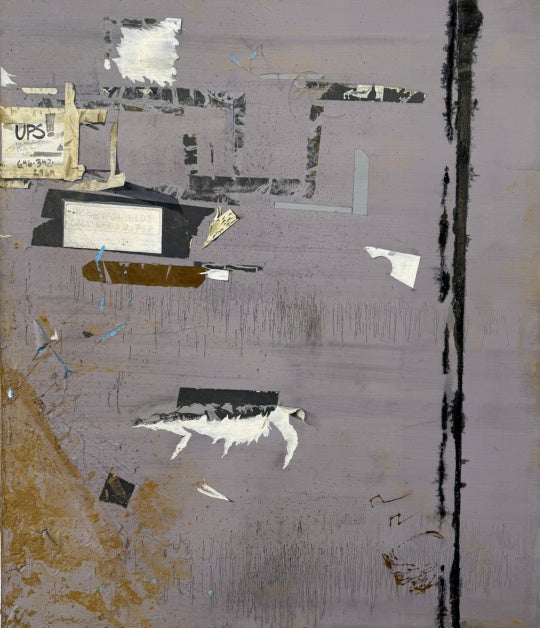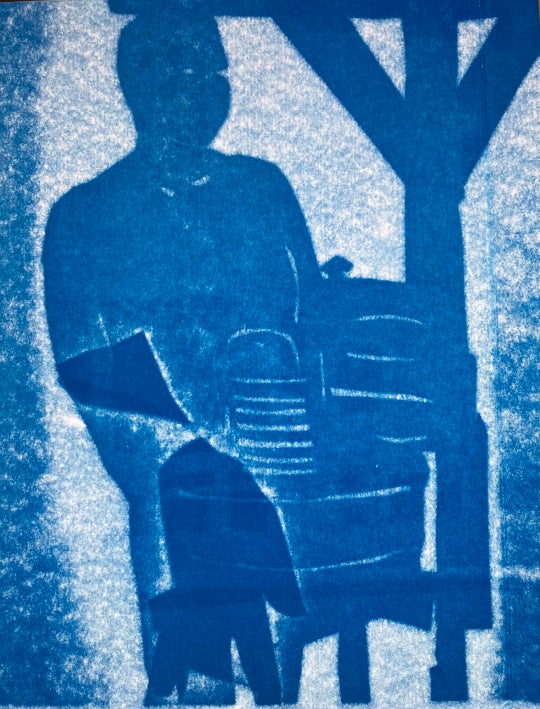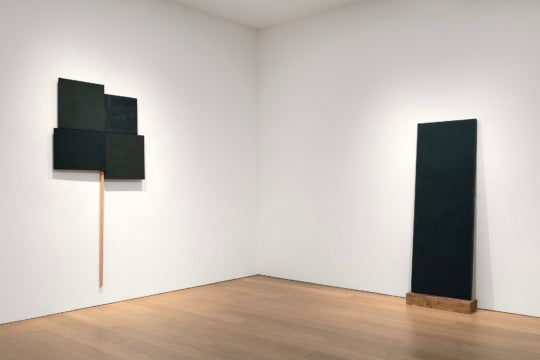
66 by 54 inches.
As a theme, the “artist in their studio” is a genre of painting within the Western tradition that marks the historiographical and mythological parameters that surround artists and their practice. As the site of production and the space of creative reflection, the artist’s studio continues to prove fascinating to creators and viewers alike for its constellation of associations as a spiritual, practical, romantic, and political sanctum. Mary Addison Hackett’s collection of paintings that examine the studio and creative activity are the true highlight of her inaugural exhibition at Marcia Wood’s Midtown gallery in Atlanta, titled “A Tin of Egyptian Cigarettes” [extended through Feb. 13] Activating the artist’s private environs with a subtle sense of patience and surprise, these works add to our understanding of the history of the studio genre and ask us to consider the studio as a liminal site pitched between physical, psychic, and subjective boundaries.

20 by 16 inches.
The concept of interiority as something open and closed simultaneously—public and private, geographical and ephemeral—charges these works with a curious discourse. As I meandered slowly and sporadically around the circumference of the gallery, I found myself working to negotiate a conception of where I was in relationship to these images of the artist’s personal space. While the scenes of Hackett’s personal space denote a representation of “her” space and the objects and settings that structure her everyday lived experience, the intimacy of the scale, the softness of the color palette, and the humorous inclusion of electrical cords and paperweights opens the threshold between artwork and viewer. I felt included—bound up within the site of production, close in proximity to the artist, there in the space, mirroring the journey of looking and representing.
A work like Turpentine (2012) creates its intimacy through a quality of “nearness,” or an understanding that we are in proximity to the objects, spaces, and tone of Hackett’s personal spaces. We as viewers are not only close to the site of picturing—the easel and canvas—but chummy with the marks, mess, and liquid materiality of artmaking (paint smears, oils, and primers). These indexical acts face us as does the empty room, paused between immanent action and quiet reflection.
Studio Window (2014) creates linkages between the world outside and the accumulative ecology of an artist’s studio space. The strict grid of the windowpane works to order—divide—the space of the world and the studio, but the failure of being able to turn away from the world is evident in the fragments of verse and sticky notes attached to the transparent surface and the canisters of coffee that are both reminders and appropriations of daily life.

oil on canvas, 9 by 7 inches.
The spaces composed within Hackett’s paintings are rehearsals, of a kind. Not empty repetitions, but products of a discerning and attentive eye that render these spaces as home—owned, lived in, and loved. Simple table lamps undulate with a Van Gogh-like energy and spirit, possessing the space of the interior with a visionary, violent sparkle. Some paintings are less transcendent, as in 1968, It Was a Beautiful Cake (2014), which concentrates our attention on an empty plastic Kroger bag left on a kitchen door handle. The surprise of the gesture, the tender sweetness and simplicity of the object, demands a pause.

oil on linen, 16 by 14 inches.
While the studio paintings lend the exhibition an important theme, it is Hackett’s dialogue with painting itself that provides the coherent pulse. Whether a studio scene or a vibrant explosion of color, the paintings in this exhibition point to the shared intensities of labor, time-based processes of making, and the artist’s intimate engagement with materials that all paintings demand. The resonances between Hackett’s abstract works and her more representational paintings defy the strict categorical divisions that structure the discourse of painting, and instead draw our attention to the shared forms, colors, and marks that echo across the gallery walls. Dreamy color chords and excitingly delicate vocabulary of marks within the figurative pieces seem to nod and confirm the existence of similar patterns of brushwork and tonality in the abstract canvases Yet, I left the exhibition wondering if the task of finding (and thus, securing) similarities and formal dialogues within the two modes was a mistake? Is Hackett asking us to see the breadth of choices and decisions in contemporary painting as opposed to the limits? These questions are never set to closure in Hackett’s work, and that is what makes it so rich, so rewarding, so very good.
Mary Addison Hackett’s exhibition “A Tin of Egyptian Cigarettes” is on view at Marcia Wood Gallery through February 13.
Jordan Amirkhani is currently the visiting assistant professor of art history at the University of Tennessee Chattanooga for the 2015-16 academic year. In addition to her academic work, she serves as a regular contributor and art critic to many national arts publications, namely, the San Francisco-based contemporary art forum Daily Serving.




